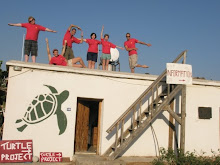

Another great night on the beach last night with lots of activity early in the evening to keep motivation high. The first turtle of the evening, on Aligadi 1, was a large green. She measured in at a whacking 104cm (length of carapace and dug two body pits before digging the egg chamber. This was followed closely by two Loggerheads, on Alagadi 1 and Alagadi 2 respectively. There were also a couple of u-turns as well just to keep us on our toes. Just before dawn, on Alagai 2 a Loggerhead came ashore and completely wasted everybodies time by digging several body pits and egg chambers before disappearing off into the sea again.
We have a many wonderful people locally who are helping the turtle project in many ways. One such person is Penny, who lives in Alagadi and provides us with the most wonderful cakes every few days. Yesterdays banana cake was saved until the wee small hours of the morning and devoured on the beach. Thank you Penny!
Sleep deprivation is beginning to take it's toll and most people today failed to put in an appearance much before mid afternoon! The usual insomniacs however, Ainslie, Robbo were up early; Ainslie flooding the kitchen with the washing machine and Robbo test driving the new ute and Tom and Libby manning the visitor centre.
Several blog readers have asked for a little background information of the project and also a little about more about a typical day. Since 1992 over students from British universities have taken part in the annual monitoring and conservation of marine turtles in Northern Cyprus. Work is carried out at the request and in conjunction with members of the local Society for the Protection of Turtles and the local Department of Environmental Protection.
You can get more detailed information from www.seaturtle.org/
Our work involvesnight time beach patrols at Alagadi Beach and day time patrols on few beaches on the North and West coasts as well. Those people on night patrol start at 2030 and are on the beach until 0500. Every 10 minutes, groups of 2-3 people patrol the beach and upon encountering a nesting femalerecord her activity / tags measurements etc. This can only be done once she is laying eggs as any noise or light before that stage could frighten her away. Some of the work this year will involve attaching and possibly retrieving satellite transmitters to nesting females to record their inter=nesting behaviour. Communication between the groups of the beach is by coded (sometimes so coded that the meaning is entirely lost)flashing of torches and VHF Radio.
Day work during the nesting period involves monitoring of beaches to record nesting activities, protecting nests from predation using wire screeds and relocating nests laid too close to the sea to safer sites.
In addition to the turtle work we have an information room that is visited by both tourists and locals. There are a limited number of places available for visitors to accompany us to the beach at night. We will be starting this on Sunday night. Anybody interested in taking part in the turtle spotting please come down to the Goat shed to book your place.
Ainslie

No comments:
Post a Comment